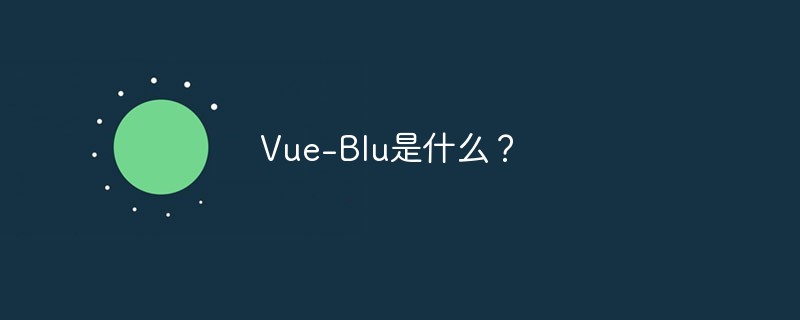What is Vue-Blu?
Vue-Blu is an open source UI component library developed based on Vuejs and Bulma; it aims to provide a fast and flexible solution for PC-side front-end development (especially middle and back-end products). Vue-Blu has comprehensive, flexible and powerful UI components with friendly API.

Vue-Blu is an open source UI component library developed based on Vuejs and Bulma; it is designed to provide a fast way for PC-side front-end development (especially middle and back-end products) and flexible solutions.
Official website address: https://chenz24.github.io/vue-blu/#/
Features
Developed based on npm webpack babel, supports ES2015
Comprehensive, flexible and powerful ui components, API friendly
Style based on Bulma framework (Flexbox based ), simple layout, responsive
Customizable
##Installation
$ npm install vue-blu --save
Quickstart
import Vue from 'vue' import VueBlu from 'vue-blu' import 'vue-blu/dist/css/vue-blu.min.css' Vue.use(VueBlu)
Compatibility
- ##Based on Vuejs2.x
- Modern browsing Server and IE10
Vue-Blu’s style library uses bulma - a new, modern, Flexbox-based Pure css framework. We do not advocate excessive 'componentization'. Elements such as layout and buttons have enough expressive power natively. After componentization, it will reduce efficiency and flexibility.
And Bulma is based on Flexbox The free open source CSS framework has been used by more than 200,000 developers; the author has also introduced this CSS framework. The current number of stars has exceeded 38.9k. It is indeed a very popular pure CSS framework
Bulma official website: http://bulma.io/
Related recommendations:Programming Study website2020 front-end vue interview questions summary (with answers)vue tutorial recommendation: The latest 5 vue.js video tutorial selections in 2020For more programming-related knowledge, please visit:
The above is the detailed content of What is Vue-Blu?. For more information, please follow other related articles on the PHP Chinese website!

Hot AI Tools

Undresser.AI Undress
AI-powered app for creating realistic nude photos

AI Clothes Remover
Online AI tool for removing clothes from photos.

Undress AI Tool
Undress images for free

Clothoff.io
AI clothes remover

Video Face Swap
Swap faces in any video effortlessly with our completely free AI face swap tool!

Hot Article

Hot Tools

Notepad++7.3.1
Easy-to-use and free code editor

SublimeText3 Chinese version
Chinese version, very easy to use

Zend Studio 13.0.1
Powerful PHP integrated development environment

Dreamweaver CS6
Visual web development tools

SublimeText3 Mac version
God-level code editing software (SublimeText3)

Hot Topics
 1387
1387
 52
52
 How to use bootstrap in vue
Apr 07, 2025 pm 11:33 PM
How to use bootstrap in vue
Apr 07, 2025 pm 11:33 PM
Using Bootstrap in Vue.js is divided into five steps: Install Bootstrap. Import Bootstrap in main.js. Use the Bootstrap component directly in the template. Optional: Custom style. Optional: Use plug-ins.
 How to add functions to buttons for vue
Apr 08, 2025 am 08:51 AM
How to add functions to buttons for vue
Apr 08, 2025 am 08:51 AM
You can add a function to the Vue button by binding the button in the HTML template to a method. Define the method and write function logic in the Vue instance.
 How to reference js file with vue.js
Apr 07, 2025 pm 11:27 PM
How to reference js file with vue.js
Apr 07, 2025 pm 11:27 PM
There are three ways to refer to JS files in Vue.js: directly specify the path using the <script> tag;; dynamic import using the mounted() lifecycle hook; and importing through the Vuex state management library.
 How to use watch in vue
Apr 07, 2025 pm 11:36 PM
How to use watch in vue
Apr 07, 2025 pm 11:36 PM
The watch option in Vue.js allows developers to listen for changes in specific data. When the data changes, watch triggers a callback function to perform update views or other tasks. Its configuration options include immediate, which specifies whether to execute a callback immediately, and deep, which specifies whether to recursively listen to changes to objects or arrays.
 What does vue multi-page development mean?
Apr 07, 2025 pm 11:57 PM
What does vue multi-page development mean?
Apr 07, 2025 pm 11:57 PM
Vue multi-page development is a way to build applications using the Vue.js framework, where the application is divided into separate pages: Code Maintenance: Splitting the application into multiple pages can make the code easier to manage and maintain. Modularity: Each page can be used as a separate module for easy reuse and replacement. Simple routing: Navigation between pages can be managed through simple routing configuration. SEO Optimization: Each page has its own URL, which helps SEO.
 How to return to previous page by vue
Apr 07, 2025 pm 11:30 PM
How to return to previous page by vue
Apr 07, 2025 pm 11:30 PM
Vue.js has four methods to return to the previous page: $router.go(-1)$router.back() uses <router-link to="/" component window.history.back(), and the method selection depends on the scene.
 How to query the version of vue
Apr 07, 2025 pm 11:24 PM
How to query the version of vue
Apr 07, 2025 pm 11:24 PM
You can query the Vue version by using Vue Devtools to view the Vue tab in the browser's console. Use npm to run the "npm list -g vue" command. Find the Vue item in the "dependencies" object of the package.json file. For Vue CLI projects, run the "vue --version" command. Check the version information in the <script> tag in the HTML file that refers to the Vue file.
 How to use vue traversal
Apr 07, 2025 pm 11:48 PM
How to use vue traversal
Apr 07, 2025 pm 11:48 PM
There are three common methods for Vue.js to traverse arrays and objects: the v-for directive is used to traverse each element and render templates; the v-bind directive can be used with v-for to dynamically set attribute values for each element; and the .map method can convert array elements into new arrays.



